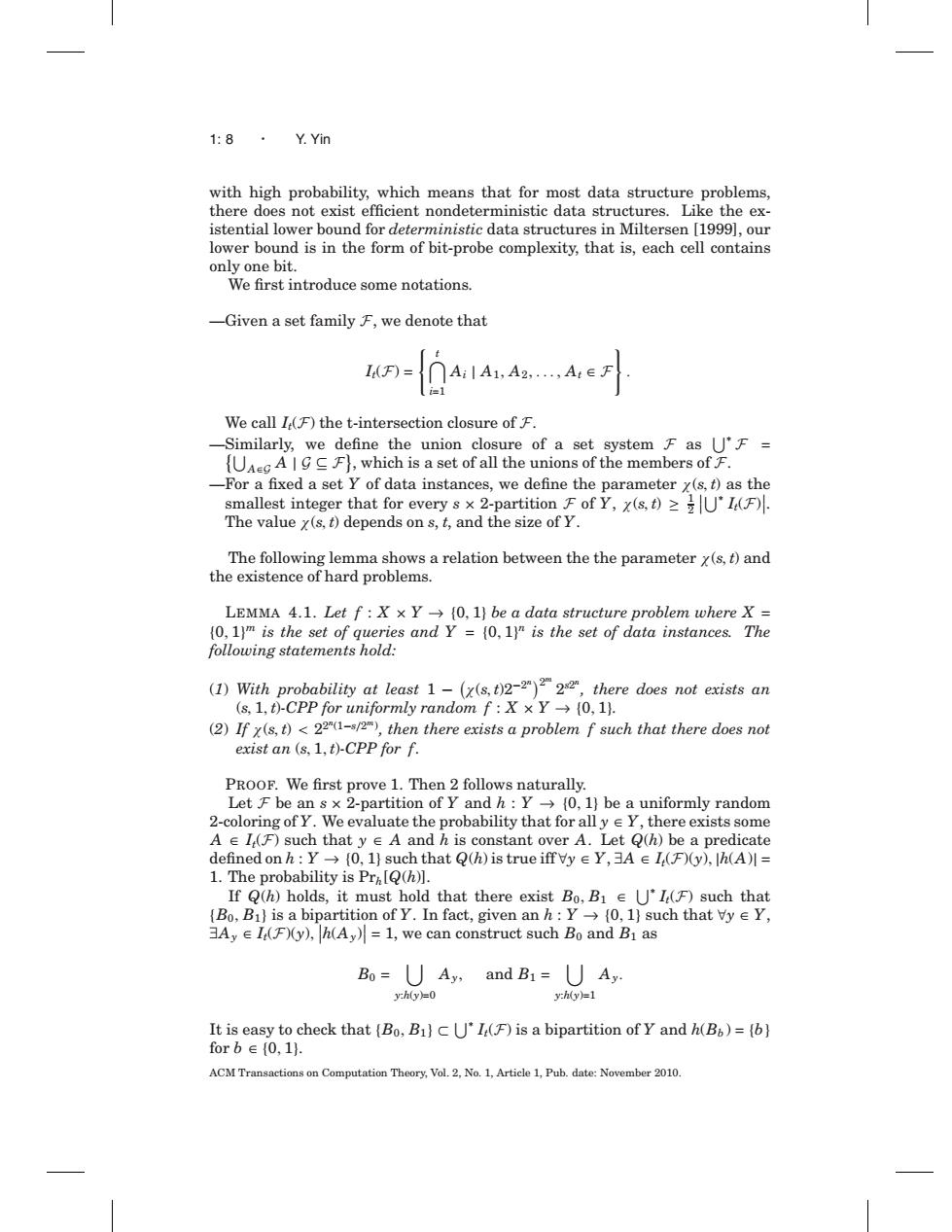正在加载图片...

1:8.Y.Yin with high probability,which means that for most data structure problems, there does not exist efficient nondeterministic data structures.Like the ex- istential lower bound for deterministic data structures in Miltersen [1999],our lower bound is in the form of bit-probe complexity,that is,each cell contains only one bit. We first introduce some notations. -Given a set family F,we denote that AilA1,A2.....A. We call IF)the t-intersection closure of F. Similarly,we define the union closure of a set system F as U'F= UAIF),which is a set of all the unions of the members of F. -For a fixed a set Y of data instances,we define the parameter x(s,t)as the smallest integer that for every s x 2-partition F of Y,x(s,t)I(F). The value x(s,t)depends on s,t,and the size of Y. The following lemma shows a relation between thethe parameter x(s,t)and the existence of hard problems. LEMMA4.l.Letf:X×Y→{0,l)be a data structure problem where X= (0,1ym is the set of queries and Y =(0,1y"is the set of data instances.The following statements hold: (1)With probability at least 1-(x(s,t)2-2)222,there does not exists an (s,1,t)-CPP for uniformly random f:XxY(0,1). (2)If x(st)<),then there exists a problem f such that there does not exist an (s,1,t)-CPP for f. PROOF.We first prove 1.Then 2 follows naturally. Let F be an s×2-partition of y and h:y→{0,l}be a uniformly random 2-coloring of Y.We evaluate the probability that for ally e Y,there exists some A I(F)such that y e A and h is constant over A.Let Q(h)be a predicate defined on h:Y→{0,l}such that Q(h)is true iffVy∈Y,3A∈I(F)y),lh(AI= 1.The probability is Pr[Q(h)]. If Q(h)holds,it must hold that there exist Bo,B1(F)such that (Bo,B1)is a bipartition of Y.In fact,given an h:Y(0,1)such that Vy e Y, Ay I(F)(y),h(Ay)=1,we can construct such Bo and Bi as Bo=Ay,and B1=Ay. y:h(y=0 y:h(y)=1 It is easy to check that (Bo,B1)CUI(F)is a bipartition of Y and h(B)=(b} forb∈{0,1. ACM Transactions on Computation Theory,Vol.2,No.1,Article 1,Pub.date:November 2010.1: 8 · Y. Yin with high probability, which means that for most data structure problems, there does not exist efficient nondeterministic data structures. Like the existential lower bound for deterministic data structures in Miltersen [1999], our lower bound is in the form of bit-probe complexity, that is, each cell contains only one bit. We first introduce some notations. —Given a set family F, we denote that It(F) =
t i=1 Ai | A1, A2,..., At ∈ F . We call It(F) the t-intersection closure of F. —Similarly, we define the union closure of a set system F as ∗ F = A∈G A | G ⊆ F , which is a set of all the unions of the members of F. —For a fixed a set Y of data instances, we define the parameter χ(s,t) as the smallest integer that for every s × 2-partition F of Y, χ(s,t) ≥ 1 2 ∗ It(F) . The value χ(s,t) depends on s, t, and the size of Y. The following lemma shows a relation between the the parameter χ(s,t) and the existence of hard problems. LEMMA 4.1. Let f : X × Y → {0, 1} be a data structure problem where X = {0, 1}m is the set of queries and Y = {0, 1}n is the set of data instances. The following statements hold: (1) With probability at least 1 − χ(s,t)2−2n 2m 2s2n , there does not exists an (s, 1,t)-CPP for uniformly random f : X × Y → {0, 1}. (2) If χ(s,t) < 22n(1−s/2m) , then there exists a problem f such that there does not exist an (s, 1,t)-CPP for f. PROOF. We first prove 1. Then 2 follows naturally. Let F be an s × 2-partition of Y and h : Y → {0, 1} be a uniformly random 2-coloring of Y. We evaluate the probability that for all y ∈ Y, there exists some A ∈ It(F) such that y ∈ A and h is constant over A. Let Q(h) be a predicate defined on h : Y → {0, 1} such that Q(h) is true iff ∀y ∈ Y, ∃A ∈ It(F)(y),|h(A)| = 1. The probability is Prh[Q(h)]. If Q(h) holds, it must hold that there exist B0, B1 ∈ ∗ It(F) such that {B0, B1} is a bipartition of Y. In fact, given an h : Y → {0, 1} such that ∀y ∈ Y, ∃Ay ∈ It(F)(y), h(Ay) = 1, we can construct such B0 and B1 as B0 = y:h(y)=0 Ay, and B1 = y:h(y)=1 Ay. It is easy to check that {B0, B1} ⊂ ∗ It(F) is a bipartition of Y and h(Bb ) = {b} for b ∈ {0, 1}. ACM Transactions on Computation Theory, Vol. 2, No. 1, Article 1, Pub. date: November 2010.��